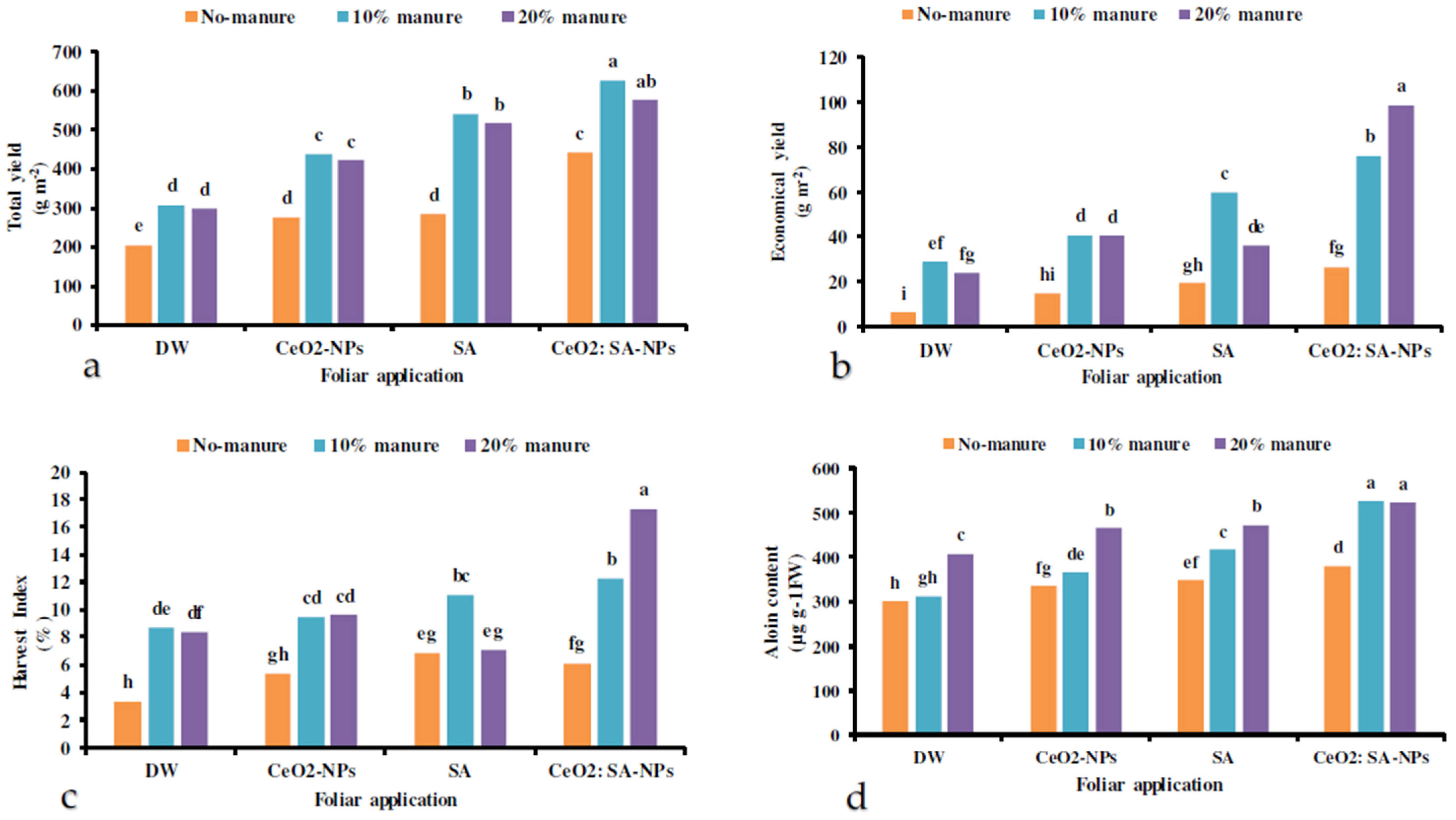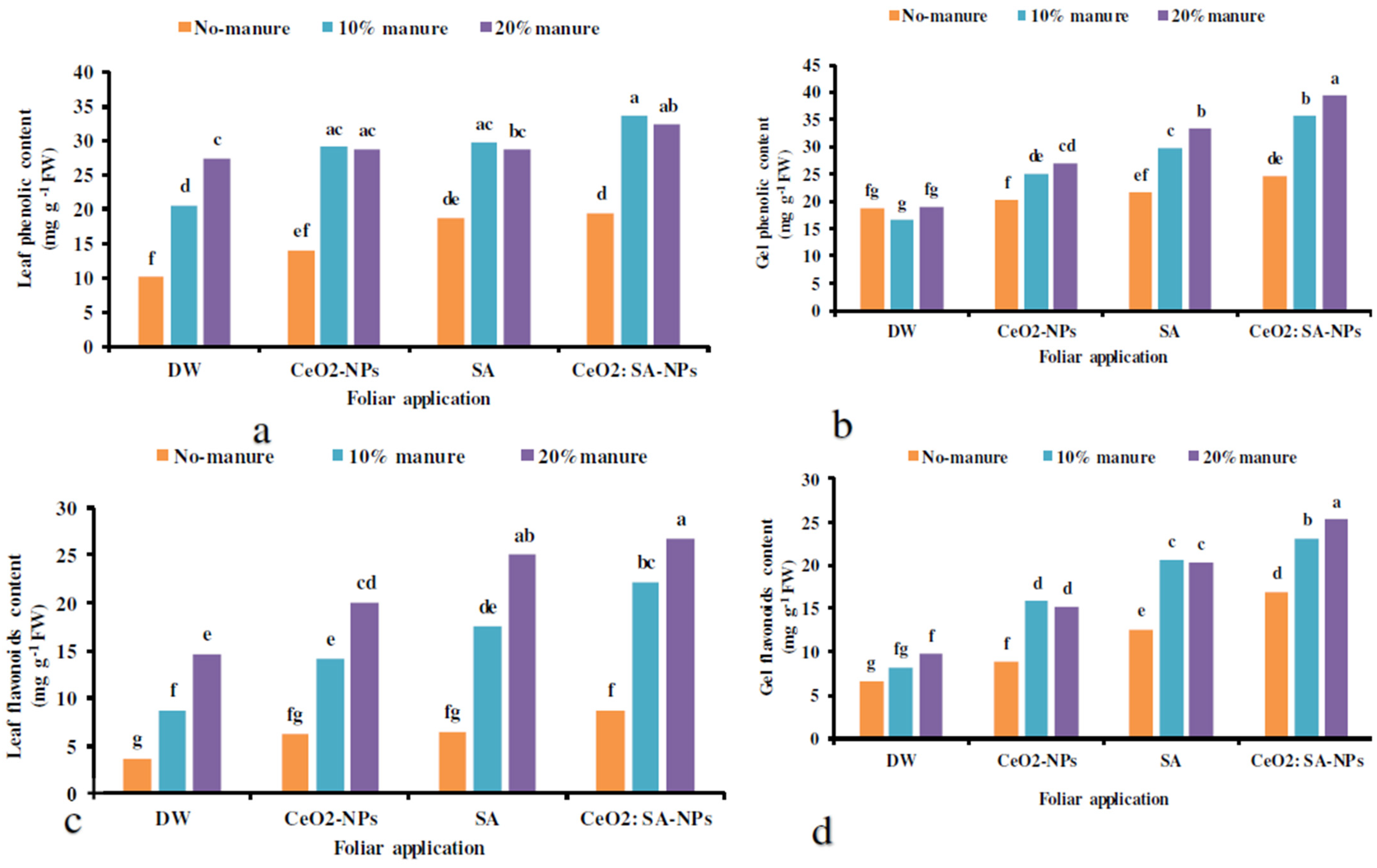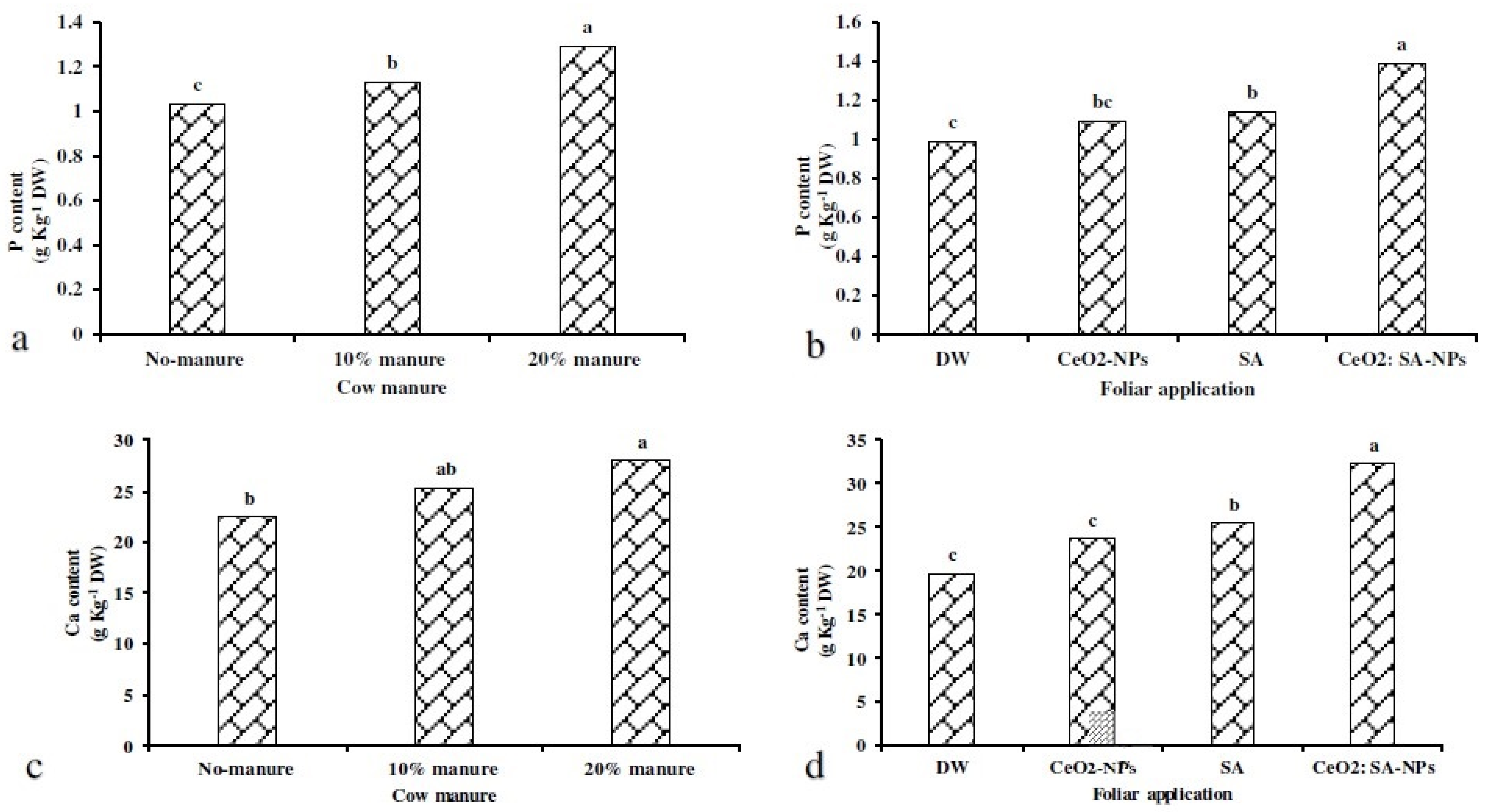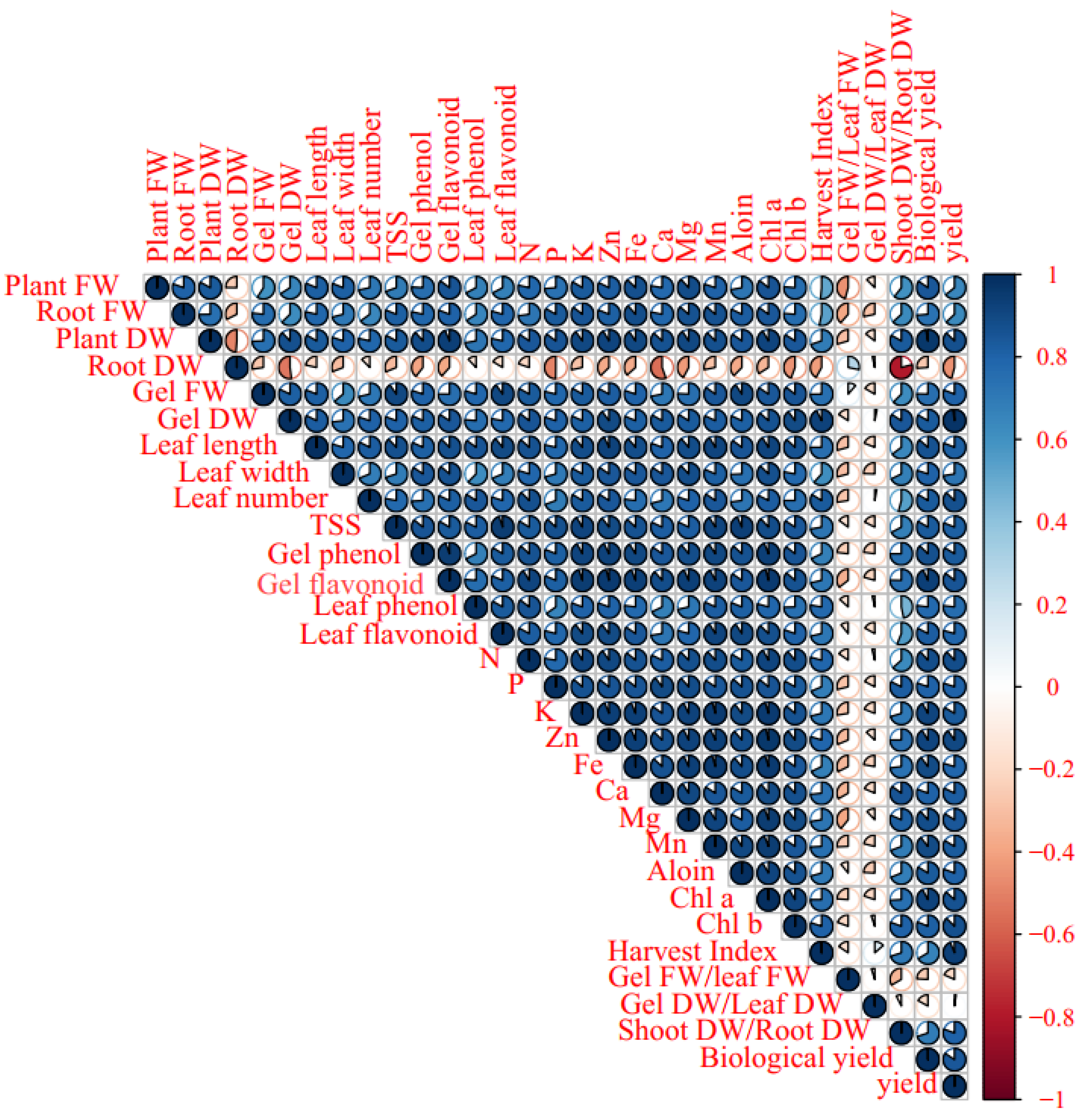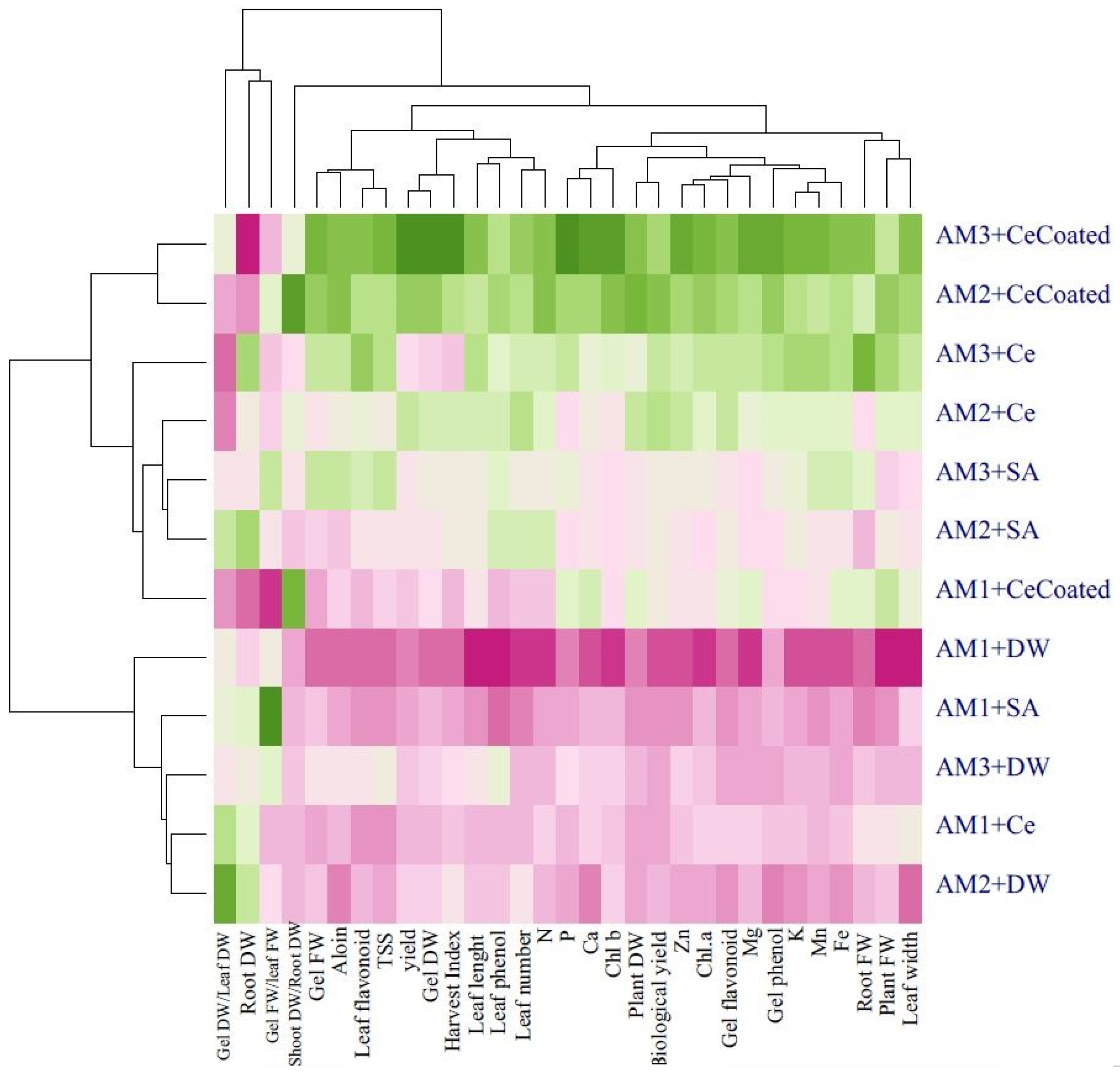Figure 1.
TEM image of sonochemical synthesis of CeO2-SA nanoparticles (left), and DLS analysis of CeO2-SA nanoparticles (right).
Figure 1.
TEM image of sonochemical synthesis of CeO2-SA nanoparticles (left), and DLS analysis of CeO2-SA nanoparticles (right).
Figure 2.
The interaction effects of animal manure application (no-manure, 10%, and 20% v/v) and foliar spray of distilled water (DW), salicylic acid (SA), cerium oxide nanoparticles (CeO2-NPs), and cerium oxide salicylic acid nanoparticles (CeO2: SA-NPs) on the above-ground parts (a) and leaf dry weight (b) of Aloe vera L. plants. Significant differences among treatments are indicated by the different Latin letters.
Figure 2.
The interaction effects of animal manure application (no-manure, 10%, and 20% v/v) and foliar spray of distilled water (DW), salicylic acid (SA), cerium oxide nanoparticles (CeO2-NPs), and cerium oxide salicylic acid nanoparticles (CeO2: SA-NPs) on the above-ground parts (a) and leaf dry weight (b) of Aloe vera L. plants. Significant differences among treatments are indicated by the different Latin letters.
Figure 3.
The interaction effects of soil-based animal manure application (no-manure, 10%, and 20% v/v) and foliar spray of distilled water (DW), salicylic acid (SA), cerium oxide nanoparticles (CeO2-nanoparticles), and cerium oxide salicylic acid nanoparticles (CeO2: SA-nanoparticles) on the total yield (a), economic yield (b), harvest index (c), and aloin content (d) of Aloe vera L. plants. Significant differences among treatments are indicated by the different Latin letters on bars.
Figure 3.
The interaction effects of soil-based animal manure application (no-manure, 10%, and 20% v/v) and foliar spray of distilled water (DW), salicylic acid (SA), cerium oxide nanoparticles (CeO2-nanoparticles), and cerium oxide salicylic acid nanoparticles (CeO2: SA-nanoparticles) on the total yield (a), economic yield (b), harvest index (c), and aloin content (d) of Aloe vera L. plants. Significant differences among treatments are indicated by the different Latin letters on bars.
Figure 4.
The interaction effects of soil-based animal manure application (0%, 10%, and 20% v/v) and foliar use of distilled water (DW), salicylic acid (SA), cerium oxide nanoparticles (CeO2-nanoparticles), and cerium oxide salicylic acid nanoparticles (CeO2: SA-nanoparticles) on the phenolics content of the leaves (a) and gel (b) as well as the flavonoids content of the leaf (c) and gel (d) of Aloe vera L. plants. Significant differences among treatments are indicated by the different Latin letters on bars.
Figure 4.
The interaction effects of soil-based animal manure application (0%, 10%, and 20% v/v) and foliar use of distilled water (DW), salicylic acid (SA), cerium oxide nanoparticles (CeO2-nanoparticles), and cerium oxide salicylic acid nanoparticles (CeO2: SA-nanoparticles) on the phenolics content of the leaves (a) and gel (b) as well as the flavonoids content of the leaf (c) and gel (d) of Aloe vera L. plants. Significant differences among treatments are indicated by the different Latin letters on bars.
Figure 5.
The interaction effects of soil-based animal manure application (0%, 10%, and 20% v/v) and foliar spray of distilled water (DW), salicylic acid (SA), cerium oxide nanoparticles (CeO2-nanoparticles), and cerium oxide salicylic acid nanoparticles (CeO2: SA-nanoparticles) on the elemental content of Aloe vera plants (a–f). Significant differences among treatments are indicated by the different Latin letters.
Figure 5.
The interaction effects of soil-based animal manure application (0%, 10%, and 20% v/v) and foliar spray of distilled water (DW), salicylic acid (SA), cerium oxide nanoparticles (CeO2-nanoparticles), and cerium oxide salicylic acid nanoparticles (CeO2: SA-nanoparticles) on the elemental content of Aloe vera plants (a–f). Significant differences among treatments are indicated by the different Latin letters.
Figure 6.
The effects of soil-based animal manure application (0%, 10%, and 20% v/v) on P (a) and Ca (c) content, and the foliar spray of distilled water (DW), salicylic acid (SA), cerium oxide nanoparticles (CeO2-nanoparticles), and cerium oxide salicylic acid nanoparticles (CeO2: SA-nanoparticles) on P (b) and Ca (d) content of Aloe vera L. plants. Significant differences among treatments are indicated by the different Latin letters.
Figure 6.
The effects of soil-based animal manure application (0%, 10%, and 20% v/v) on P (a) and Ca (c) content, and the foliar spray of distilled water (DW), salicylic acid (SA), cerium oxide nanoparticles (CeO2-nanoparticles), and cerium oxide salicylic acid nanoparticles (CeO2: SA-nanoparticles) on P (b) and Ca (d) content of Aloe vera L. plants. Significant differences among treatments are indicated by the different Latin letters.
Figure 7.
Pearson’s correlation heat map of soil-based animal manure use × foliar applications (distilled water, salicylic acid, cerium oxide nanoparticles, and CeO2: SA-nanoparticles) on the growth, physiological responses, and elemental content of Aloe vera L. plants. FW and DW refer to fresh and dry weight, respectively.
Figure 7.
Pearson’s correlation heat map of soil-based animal manure use × foliar applications (distilled water, salicylic acid, cerium oxide nanoparticles, and CeO2: SA-nanoparticles) on the growth, physiological responses, and elemental content of Aloe vera L. plants. FW and DW refer to fresh and dry weight, respectively.
Figure 8.
Heat map of cluster analysis dendrogram for the effects of soil-based animal manure use and foliar application (distilled water, salicylic acid, cerium oxide nanoparticles, and CeO2:SA-nanoparticles) on the growth, physiological responses, and elemental content of Aloe vera L. plants. FW and DW refer to fresh and dry weight, respectively. AM1 = without animal manure), AM2 = 10% animal manure, and AM3 = 20% animal manure. SA is salicylic acid), Ce is cerium oxide nanoparticles, and CeCoated is CeO2: SA-nanoparticles. The green color and the purple color show the positive and the negative response of the evaluated traits to the treatments, respectively. Moreover, the darker green indicates more positive response, and the darker purple indicates more negative responses.
Figure 8.
Heat map of cluster analysis dendrogram for the effects of soil-based animal manure use and foliar application (distilled water, salicylic acid, cerium oxide nanoparticles, and CeO2:SA-nanoparticles) on the growth, physiological responses, and elemental content of Aloe vera L. plants. FW and DW refer to fresh and dry weight, respectively. AM1 = without animal manure), AM2 = 10% animal manure, and AM3 = 20% animal manure. SA is salicylic acid), Ce is cerium oxide nanoparticles, and CeCoated is CeO2: SA-nanoparticles. The green color and the purple color show the positive and the negative response of the evaluated traits to the treatments, respectively. Moreover, the darker green indicates more positive response, and the darker purple indicates more negative responses.
Figure 9.
Principal component analysis (PCA) of soil-based animal manure and foliar applications (distilled water, salicylic acid, cerium oxide nanoparticles, and CeO2: SA-nanoparticles) on the growth, physiological responses, and elemental content of Aloe vera L. plants. FW and DW refer to fresh and dry weight, respectively.
Figure 9.
Principal component analysis (PCA) of soil-based animal manure and foliar applications (distilled water, salicylic acid, cerium oxide nanoparticles, and CeO2: SA-nanoparticles) on the growth, physiological responses, and elemental content of Aloe vera L. plants. FW and DW refer to fresh and dry weight, respectively.
Table 1.
Physico-chemical characteristics of soil and cow manure.
Table 1.
Physico-chemical characteristics of soil and cow manure.
| Characteristic | Soil Texture Class | Organic Carbon (%) | pH | EC (dSm−1) | N (%) | P (%) | K (%) | Fe (mg kg−1) | Mn (mg kg−1) | Zn (mg kg−1) |
|---|
| Soil | Loam sandy clay | 0.59 | 7.8 | 1.7 | 0.07 | 6 | 290 | 2.6 | 6.5 | 0.7 |
| Cow manure | - | 17.4 | 7.9 | 1.9 | 2.4 | 0.6 | 0.67 | 1412 | 157 | 201 |
Table 2.
ANOVA for the effect of animal manure (0%, 10%, and 20% v/v) and foliar applications (salicylic acid, CeO2-nanoparticles, and CeO2: SA-nanoparticles) on Aloe vera L. growth characteristics.
Table 2.
ANOVA for the effect of animal manure (0%, 10%, and 20% v/v) and foliar applications (salicylic acid, CeO2-nanoparticles, and CeO2: SA-nanoparticles) on Aloe vera L. growth characteristics.
| S. O. V | df | Above-Ground Parts Fresh Weight | Leaf Dry Weight | Leaf Number | Leaf Diameter | Leaf Length | Root Dry Weight |
|---|
| Animal manure (M) | 2 | 28,350.1948 * | 444.458 ** | 102.083 ** | 3.992 ** | 383.630 ** | 5.800 ns |
| Foliar treatments (F) | 3 | 84,543.4358 * | 893.879 ** | 34.917 ** | 17.760 ** | 204.888 * | 50.347 ns |
| F × M | 6 | 5290.046 ** | 27.929 ** | 1.528 ns | 0.423 ns | 6.175 ns | 5.155 ns |
| C. V. | - | 5.61 | 10.98 | 10.84 | 7.28 | 5.14 | 6.9 |
Table 3.
The effects of salicylic acid (SA), CeO2-NPs, and CeO2: SA-NPs foliar treatments and 10% and 20% of soil-based animal manure use on leaves’ number and diameter, and leaf length of Aloe vera L. plants.
Table 3.
The effects of salicylic acid (SA), CeO2-NPs, and CeO2: SA-NPs foliar treatments and 10% and 20% of soil-based animal manure use on leaves’ number and diameter, and leaf length of Aloe vera L. plants.
| | Leaf Number | Leaf Diameter (cm) | Leaf Length (cm) |
|---|
| A-Foliar application |
| Control | 8.5 d | 6.9 c | 29 d |
| SA | 10.5 c | 8.4 b | 32 c |
| CeO2-NPs | 12.2 b | 9.3 a,b | 36 b |
| CeO2: SA-NPs | 13 a | 10.1 a | 40 a |
| B-Animal manure |
| control | 7.7 b | 7 b | 28.29 b |
| 10% | 13.1 a | 8.8 a,b | 36.52 a |
| 20% | 12.3 a | 8.86 a | 39.13 a |
Table 4.
Interaction effects of soil-based animal manure (0%, 10%, and 20% v/v) use and foliar applications (no-foliar, SA, CeO2-nanoparticles, and CeO2: SA-nanoparticles) on Aloe vera L. plants’ growth and physiological traits.
Table 4.
Interaction effects of soil-based animal manure (0%, 10%, and 20% v/v) use and foliar applications (no-foliar, SA, CeO2-nanoparticles, and CeO2: SA-nanoparticles) on Aloe vera L. plants’ growth and physiological traits.
| A-Animal Manure (% v/v) | B-Foliar Application | Gel Fresh Weight (g) | Gel Dry Weight (g) | Shoot Dry Weight/Root Dry Weight | Root Fresh Weight (g) | Gel Fresh Weight/Leaf Fresh Weight | Gel Dry Weight/Leaf Dry Weight |
|---|
| control | Control | 18.3 g | 0.083 h | 1.17 e | 6.5 d,e | 0.09 b,d | 0.010 a |
| SA | 29 d,f | 0.18 f | 1.28 e | 7.6 b,c | 0.129 a | 0.011 a |
| CeO2-NPs | 35 c | 0.18 f | 1.35 e | 7.4 c,d | 0.07 d | 0.013 a |
| CeO2: SA-NPs | 28 d,f | 0.14 g | 7.2 b | 3.9 fg | 0.05 e | 0.007 a |
| 10% manure | control | 30 c,d | 0.22 e | 1.27 e | 7.5 c,d | 0.08 c,d | 0.015 a |
| SA | 45.6 b | 0.24 d | 1.9 e | 8.3 b | 0.09 b–d | 0.0126 a |
| CeO2-NPs | 24.6 e,f | 0.15 g | 3.8 c | 7.9 b–d | 0.08 d | 0.006 a |
| CeO2: SA-NPs | 34.3 c | 0.29 c | 7.9 b | 4.9 e,f | 0.101 bc | 0.007 a |
| 20% manure | control | 45 b | 0.19 f | 1.7 d,e | 7.5 c,d | 0.104 b | 0.011 a |
| SA | 23.6 e,f | 0.20 e,f | 2.9 c,d | 7.5 c,d | 0.101 b | 0.001 a |
| CeO2-NPs | 52 a | 0.37 b | 2.4 c–e | 10.4 a | 0.080 d | 0.006 a |
| CeO2: SA-NPs | 56.6 a | 0.45 a | 13.1 a | 7.8 cd | 0.07 d | 0.011 a |
| | Animal manure (M) | 1452.694 ** | 0.060 ns | 16.111 ** | 1848.308 ** | 0.0001 ** | 0.0008 ** |
| | Foliar treatments (F) | 420.769 ** | 0.060 ** | 126.230 ** | 1825.537 ** | 0.002 ** | 0.0003 ** |
| | F × M | 102.99 ** | 0.008 ** | 7.840 ** | 126.345 ** | 0.001 ** | 0.0001 ** |
| | C. V. | 8.64 | 6.47 | 8.9 | 9.11 | 8.63 | 10.1 |
Table 5.
Interaction effects of soil-based animal manure (0%, 10%, and 20% v/v) use and foliar applications (no-foliar, SA, CeO2-nanoparticles, and CeO2: SA-nanoparticles) on Aloe vera L. plants’ chlorophyll a and b as well as total soluble solids (TSS) content.
Table 5.
Interaction effects of soil-based animal manure (0%, 10%, and 20% v/v) use and foliar applications (no-foliar, SA, CeO2-nanoparticles, and CeO2: SA-nanoparticles) on Aloe vera L. plants’ chlorophyll a and b as well as total soluble solids (TSS) content.
| Animal Manure (% v/v) | Foliar Application | Chl a Content (mg g−1 FW) | Chl b Content (mg g−1 FW) | TSS (°Brix) |
|---|
| control | Control | 1.13 k | 0.50 g | 1.03 f |
| SA | 1.60 j | 0.93 d,f | 1.5 e |
| CeO2-NPs | 1.8 h,i | 0.96 d,f | 2.4 c |
| CeO2: SA-NPs | 1.7 i,j | 0.80 f | 1.3 e,f |
| 10% manure | control | 2.1 f,g | 1.0 d,e | 2.2 c,d |
| SA | 2.3 e | 1.0 d,e | 2.9 b |
| CeO2-NPs | 2.0 g,h | 0.9 e,f | 1.3 e,f |
| CeO2: SA-NPs | 2.5 d | 1.06 d | 2.4 c |
| 20% manure | control | 2.7 c | 1.23 c | 3.2 a |
| SA | 2.2 e,f | 1.03 d,e | 1.9 d |
| CeO2-NPs | 3.0 b | 1.5 b | 3.2 a |
| CeO2: SA-NPs | 3.2 a | 1.7 a | 3.2 a |
| | Animal manure (M) | 1452.694 ** | 0.060 ns | 16.111 ** |
| | Foliar treatments (F) | 420.769 ** | 0.060 ** | 126.230 ** |
| | F × M | 102.99 ** | 0.008 ** | 7.840 ** |
| | C. V. | 8.64 | 6.47 | 8.9 |
Table 6.
ANOVA for the effect of soil-based animal manure (no-manure, 10%, and 20% v/v) use and foliar applications (no-foliar, salicylic acid, cerium oxide nanoparticles, and CeO2: SA-nanoparticles) on Aloe vera L. plants’ aloin content and yield traits.
Table 6.
ANOVA for the effect of soil-based animal manure (no-manure, 10%, and 20% v/v) use and foliar applications (no-foliar, salicylic acid, cerium oxide nanoparticles, and CeO2: SA-nanoparticles) on Aloe vera L. plants’ aloin content and yield traits.
| S. O. V. | Total Yield | Economic Yield | Harvest Index | Aloin Content |
|---|
| Animal manure (M) | 108,704.784 ** | 4612.050 ** | 101.496 ** | 48,009.375 ** |
| Foliar treatments (F) | 122,589.717 ** | 3650.188 ** | 42.309 ** | 28,678.352 ** |
| F × M | 3882.060 ** | 613.543 ** | 17.783 ** | 2876.783 ** |
| C. V. | 9.22 | 13.64 | 15.34 | 3.97 |
Table 7.
ANOVA for the effects of soil-based animal manure (0%, 10%, and 20% v/v) use and foliar applications (no-foliar, salicylic acid, cerium oxide nanoparticles, and CeO2: SA-nanoparticles) on Aloe vera L. plants’ phenolics and flavonoids content as well as elemental content.
Table 7.
ANOVA for the effects of soil-based animal manure (0%, 10%, and 20% v/v) use and foliar applications (no-foliar, salicylic acid, cerium oxide nanoparticles, and CeO2: SA-nanoparticles) on Aloe vera L. plants’ phenolics and flavonoids content as well as elemental content.
| S. O. V. | df | Gel Flavonoids Content | Leaf Flavonoids Content | Gel Phenolics Content | Leaf Phenolics Content | N | P | K | Ca | Mg | Fe | Zn | Mn |
|---|
| Animal manure (M) | 2 | 147.743 ** | 714.539 ** | 214.209 ** | 694.209 ** | 172.3 ** | 0.21 ** | 150.1 ** | 90.7 ** | 230.1 ** | 5007.8 ** | 2721.3 ** | 606.6 ** |
| Foliar treatments (F) | 3 | 308.842 ** | 169.957 ** | 364.570 ** | 364.570 ** | 139.45 ** | 0.26 ** | 153.8 ** | 251.6 ** | 517.6 ** | 7513.8 ** | 2691.6 ** | 472.9 ** |
| F × M | 6 | 7.757 ** | 13.355 ** | 36.635 ** | 36.635 ** | 7.84 ** | 0.004 ns | 3.86 ** | 4.66 ns | 10.36 ** | 104.6 ** | 65.4 ** | 14.5 ** |
| C.V. | | 7.81 | 15.75 | 7.74 | 11.79 | 6.2 | 7.2 | 4.9 | 7.2 | 4.8 | 2.3 | 5 | 5.1 |


